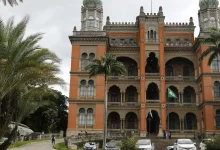Art and Activism: When Protests Target Works of Art
In the age of TikTok, everyone wants their 15 minutes of fame, or even just a few seconds. This weekend, the champions in the toxic podium of social media were the two activists who threw an orange-colored soup at the “Mona Lisa” at the Louvre Museum in Paris.
Leonardo Da Vinci’s masterpiece, it seems, emerged unscathed, as it is hung behind a pane of bulletproof glass. But the damage is not physical. It’s a matter of image, and image is everything in a world marked by distraction and the frantic scrolling of fingers on screens in search of the latest shocking viral moment.
The act at the world’s largest museum this weekend was a protest against structural problems faced by French farmers, a movement that is spreading across Europe with tractors from the countryside also advancing on Berlin and other cities.
No matter the issue of the day. Far from the streets and inside the museums, tomato soup has been thrown on Van Gogh’s sunflowers, pea soup on another canvas by the Dutch artist, black paint on a Klimt painting. Hands have been stuck on a Goya painting, Botticelli’s “Primavera,” and Da Vinci’s “Last Supper.” Scribbles have been made on the glass of Warhol’s Campbell’s soup cans—would it be redundant to say “soup” here too?
The motives behind each attack vary. They range from problems with museums funded by the oil and fossil fuel industry, protests against neglect in relation to climate change, and now the thorny issue of European farmers pressured by a market in flames, exacerbated by ongoing wars around the globe.
There seems to be no ceasefire in sight between Israelis and Palestinians who are at each other’s throats, just as there is no stopping the attacks on works of art in museums around the world, whatever the current reason may be.
And the reason behind this strategy does not change, it is the common denominator. Destruction, even if symbolic, is sexy, almost pornographic. We can’t seem to take our eyes off it.
Far from Paris, we have seen iconoclastic acts against historical ruins at the hands of the Islamic State, and right at home, in a continuous loop, we have witnessed the images of the coup d’état attacks of January 8th last year, the golden clock thrown to the ground, Di Cavalcanti’s painting stabbed, the Supreme Court chairs, a design by Jorge Zalszupin, thrown into the open.
Through luck or precaution, today more than by accident, the world’s major museums already have their masterpieces safeguarded by glass, acrylic, or other protective barriers. Activists have also said that they do not aim to destroy artistic heritage, but they want to draw attention. Fair enough, but they could find another way to wear a watermelon around their necks.
Nothing against the cause they want to show and draw attention to, but the attack on works of art victimizes what is most human and common to all of us, the free expression that provokes, seduces, enchants, or inspires debates, asks more questions than it answers, the healthiest thing we can have in an era of nervous fingers and attention deficit.
Transforming museums into battlefields, spaces of tension, is not the way forward for the exchange of ideas, for debate and denunciation. Works of art alone, especially those that have survived centuries or millennia as testimonies of our delusions and our anguish, witness and denounce other evils and other pains in turn.
The activists who put their own pain above that of others, above the tortuous path of expression crossed by these artists, are as insensitive as the monsters they want to denounce.
Da Vinci, when he portrayed his Gioconda and made the painting the ultimate manifesto of the plastic translation of what it means to be human in the face of a nature impossible to capture in all its splendor, is not to blame for the problems of French farmers. Neither is Goya, nor Van Gogh, nor Di Cavalcanti, nor Warhol.












